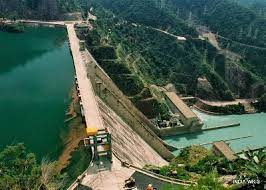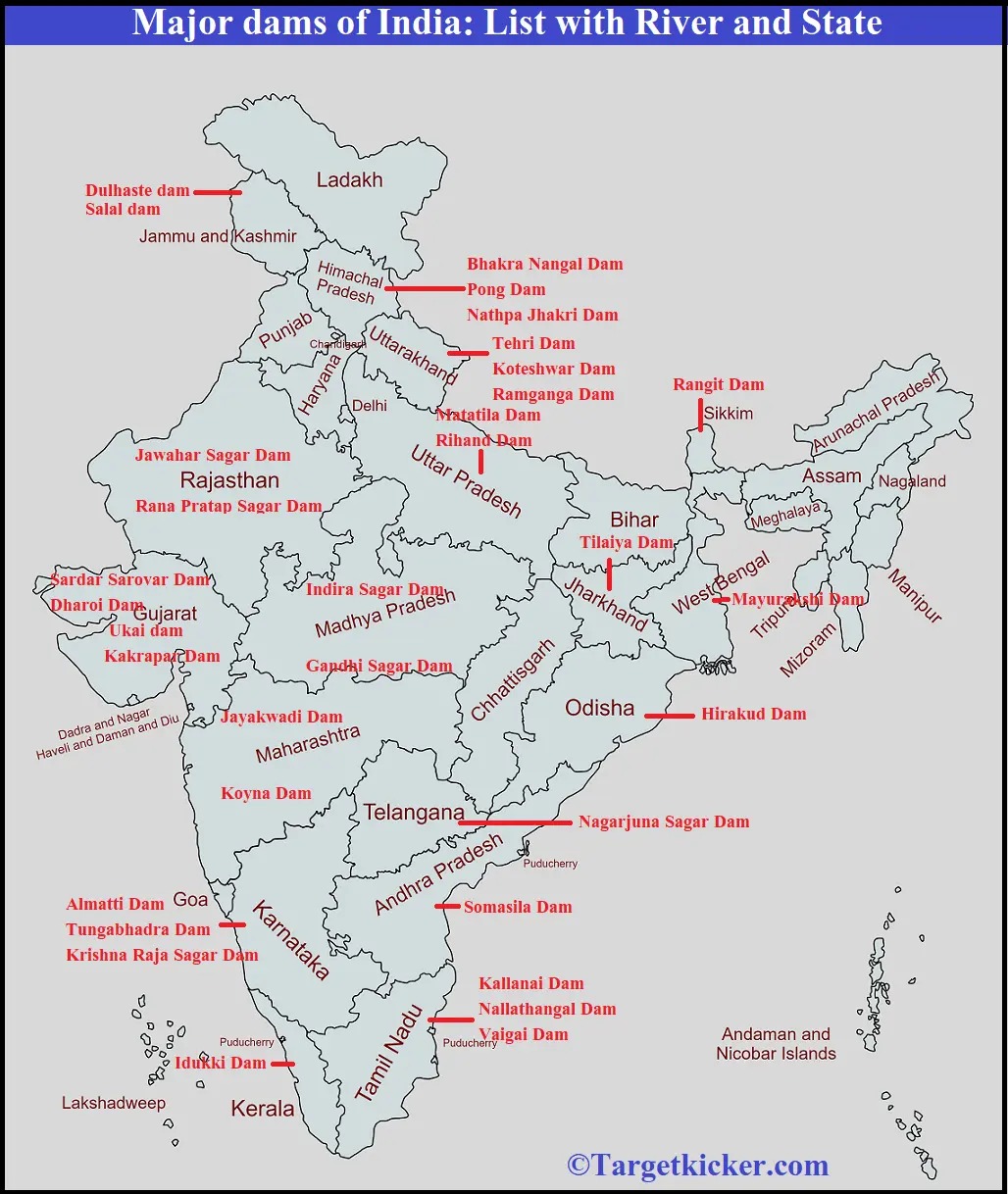
Dam Safety
Dam Safety
Important for Prelims Exam:
Chungchang Dam, Tehri Dam, Bhakra, Sardar Sarovar, Hirakud, Nagarjuna, Baglihar, Nathpa Jhakri, Kadana Chandil, Almatti, Walayar, Gandhi Sagar Dam and Hydroelectric Projects, Ministry of Jal Shakti, Safety Act, 2021, Dam Safety Organization, National Dam security authority
Important for Mains Exam:
GS-3: Dam Insecurity Scenario in India, Advantages and Disadvantages of Dams, Major Causes of Dam Breakage
November 06, 2023
Context:
Chungchang Dam in Sikkim collapsed recently. More than thirty people died in this accident. In this way, questions are again being raised regarding the strength and durability of dams in the country. Many such dams in the country are in a dilapidated condition and there is always a possibility of their collapse. The condition of big dams in India is more pathetic than that of small dams. In the course of modern development, many of the dams which supply water for irrigation, drinking water, industrial use, electricity generation, horticulture etc. have become dilapidated. Therefore, there is a need to pay special attention to better monitoring and security of all the important dams of the country.
Dam Insecurity Scenario in India:
- According to Jal Shakti Ministry data, there are 5,745 large dams in India (including those under construction). Of these, more than 75 per cent of dams are more than 20 years old and about 220 dams are more than 100 years old.
- Of these, 447 dams are in crisis:
- All these dams are located in the states of Maharashtra, Madhya Pradesh, Gujarat, Chhattisgarh, Karnataka, Bihar and Uttarakhand.
- According to the data, among the hundred year old dams, there are 63 dams in Madhya Pradesh, 44 in Maharashtra, 30 in Gujarat, 25 in Rajasthan and 21 in Telangana.
- Many dams of India are in extremely dangerous areas from earthquake point of view. In areas where small scale earthquakes occur regularly, there is a greater possibility of dams breaking or cracking.
- Tehri Dam in Uttarakhand is susceptible to earthquakes and heavy rainfall due to its large size.]
- Apart from big dams like Tehri Dam, Bhakra, Sardar Sarovar, Hirakud, Nagarjuna, Baglihar, Nathpa Jhakri, Kadana Chandil, Almatti, Walayar, Gandhi Sagar, dams located in Odisha, Tamil Nadu and Telangana are in a state of complete insecurity.
- Rajghat Dam (Chanderi), Phulwaria Dam in Nawada and Panchna Dam in Karauli, Rajasthan are in very dilapidated condition. The water of Pipri Dam in Sonbhadra district is not only poisonous, but its condition is also not good.
Global Scenario:
- Presently there are ninety-four thousand dams in China, many of which are dilapidated. Some of these are such that if they break, India and Pakistan will also be affected.
- 'Three Gorgeous' Dam, which is built on the Yangtze River, this dam of four hundred and ten miles wire length is very useful for China, but due to this dam, many areas of India are in danger of floods.
- Asia's largest dam, Hirakud, located in Odisha, constructed in 1957, is in an area where problems like excessive rainfall, earthquakes and floods are seen regularly. Built over an area of about five km, this dam has been useful in many ways, but due to its old age, it needs special care.

Benefits from Dams:
- These dams are lifelines for drinking water and irrigation, the flow of water is controlled, which is used to meet domestic, agriculture and industries.
- Hydroelectric power plants are used to generate electricity through dams.
- Currently India is getting economic benefits from the power projects being operated in Bhutan, Nepal and Bangladesh.
- The forum behind the dam can be used for water sports, irrigation or other pleasurable recovery.
- Generating electricity through dams does not cause pollution because no solar gases are released in the process.
Losses from Dams:
- There is a large scale migration of people from the dam where it is proposed.
- Construction of huge dams causes huge geological damage to the earth's surface.
- Dams take many years to build, which deteriorates the quality of life of people living in the surrounding areas.
- People have to face many problems every year due to the problems created by the dams built around Delhi (Hathnikund Barrage), Haryana, Ghaziabad, NCR.
- Due to deforestation around for the construction of dams, biodiversity decreases and the ecosystem deteriorates.
- Large scale migration occurs and agricultural development of that area is affected due to fertile agricultural land going into the dam.
- In many states including Bihar, Assam, Punjab, Odisha, Jharkhand, Madhya Pradesh, there is a loss of billions of rupees every year due to floods caused by dams.
- Where there are cracks in dams, there is huge loss of life, property and cattle.
- Village people are more affected by dams than urban people.
- Farmers, tribals and people living in rural areas face many problems related to dams, the main ones being economic loss, cultural disintegration and psychological threat of dam breakage.
Causes of Dam Breaking:
- Natural disasters: Dams are at high risk of damage due to floods and cloud bursts.
- In areas where small scale earthquakes occur regularly, there is a greater possibility of dams breaking or cracking.
- The main reason for the breach of Chugchang Dam was the burst of cloud in the glacier lake.
- Poor quality of the dam: The age of the dam depends on the quality of its construction and also the climatic suitability of large infrastructure projects. If the quality of the dam is compromised during the construction of the dam, then the new dam may also get overwhelmed and break.
- Chugchang Dam was about twenty years old.
- Climate Change: Many dams in the country have broken due to glacier melting incidents due to climate change.
- The Uttarakhand tragedy in June 2013 is a great example of climate change.
Solution:
- Technical Committee: Central Electricity Authority constituted a technical committee to study the issue of dam quality and understand their current condition in view of the potential hazards of hydropower projects.
- This committee will give suggestions to solve many questions and problems related to dams.
- Dam Safety Act, 2021: The Dam Safety Act 2021, passed by Parliament in December 2021, provides for monitoring, inspection, operation and maintenance of certain specified dams across the country.
- The Act provides for imprisonment of up to two years or fine or both for offenses under it.
- This Act applies to all dams whose height exceeds 15 metres, or whose height is between 10 meters and 15 meters with certain design and structural conditions and
- This includes dams built on interstate and intrastate rivers.
- Establishment of National Dam Safety Authority: National Dam Safety Authority (NDSA) was established by the Ministry of Jal Shakti in April 2022.
- Dam Safety Organization: This organization gives important instructions and suggestions to dam safety units before and after monsoon under the guidance of the Central Government.
- Currently twenty-nine states are included in the Dam Safety Organization.
- States should further strengthen dam safety by implementing the suggestions given by the Dam Safety Organization. This can provide relief to some extent from the problems that arise from time to time regarding dams.
- The warnings of seismologists regarding better safety and conservation of dams should be implemented.
- Immediate survey of dams and power projects should be conducted, so that their actual condition can be assessed.
- NCR falls in the earthquake sensitive area. Delhi is a state in the country which is dependent on Punjab, Uttar Pradesh and Haryana for water. Therefore, whenever there is excessive rainfall in these states, it affects Delhi also. In such a situation, Delhi government should think seriously about this.
- Dams in the country should be built keeping in mind the climate change so that these dams can withstand the rapid flow and sudden surge of water.
Conclusion:
- In the past months, floods and rains wreaked havoc in many states. Due to filling of water beyond capacity in many dams, cracks appeared in them. Apart from people and wealth, a dire situation of soil erosion was seen in them. The frequency of landslides, earthquakes, floods and excessive rainfall has increased. In India, minor breaches in dams are usually repaired or ignored. This reduces the lifespan of the dam. Sometimes even seemingly minor cracks prove to be very dangerous. In the past years, the government has shown seriousness on the pathetic condition of dams, but the way accidents related to them have come to light, it seems that there is a need to take better care of them.
Source-Jansatta
-----------------------------------------
Mains Exam Question
- Are the dams built in India highly vulnerable to natural disasters? Discuss.
- How safe are the mega hydropower projects built in India? Review.